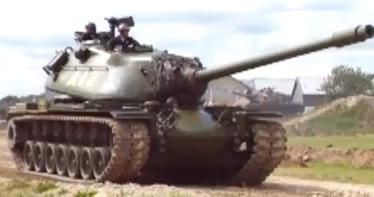America’s M103 heavy tank, which was designed after World War II, was supposed to be a match for the Soviet Union’s JS-3 heavy tank. The M103 was only in service for a short time. As the Cold War progressed, the United States began to focus on the development of main battle tanks instead of heavy tanks.
After the Second World War, the United States began working on the development of a new heavy tank.
Two prototypes of this new tank, which was designated the T43, were built in 1948. A modified version of the T43, known as the T43E1, was then developed.
Four prototypes of the T43E1 were built. Chrysler then produced 200 T431E1 heavy tanks from 1952 to 1954.
The T43E1 did not become standardized as the M103 until 1953.
However, the tanks that were built had so many flaws that the M103 heavy tank was not declared fit for service until 1957. Each tank needed more than 100 different modifications in order to be deemed fit for use on the front line.

The M103 heavy tank weighed 56 tons (56,700kg) and had armor with a maximum thickness of 7.01 inches (178mm). Its engine was not powerful enough to cope with the tank’s weight. Consequently, the M103 had a very small operational range (81 miles, or 130km), and it frequently broke down.
Because the M103 was so heavy, the armored recovery vehicles that existed when the tank was first built could not handle it. Therefore, a new armored recovery vehicle, which used components from the M103, had to be built. This new ARV became known as the M51.
The M103 has a torsion-bar suspension with seven pairs of road wheels and six return rollers. The idler is at the front and the drive sprocket is at the rear.
Main armament on the M103 heavy tank is a 4.72 inch (120mm) gun. The M103 also has two 0.3 inch (7.62mm) coaxial machine guns and a 0.5 inch (12.7mm) anti-aircraft gun.
A five-man crew is needed to operate the M103 heavy tank. The crew consists of a driver, a commander, a gunner and two loaders.
The M103 has infrared night vision.
Two variants of the M103 were designed.
The M103A1, which was introduced in 1959, had a redesigned turret and a better fire control system. A ballistic computer was added, and one of the coaxial machine guns was removed.
Many improvements were made to the M103A2, which was introduced in 1974. This variant had a new engine that increased the tank’s operational range significantly, to 295 miles (480km).
In 1963, three prototypes of the M103A2 were produced. 153 tanks were then converted to M103A2s and supplied to the US Marines, who were the last to use the M103 heavy tank.
Only 200 M103 heavy tanks were ever produced. The tank never saw combat and was never exported outside the United States. The M103 heavy tank began to be phased out of service in 1972.
M103 Heavy |
|
|---|---|
| Active: | 1957 |
| Crew: | 5 |
| Weight: | 36 tons (56,700kg) |
| Length: | 22ft 10in (7m), 37ft 1 in (11.3m) with gun forwards |
| Height: | 9ft 5in (2.9m) |
| Width: | 12ft 3in (3.8m) |
| Weapons: | Main – 4.72in (120mm) gun; Secondary – M103: 2 x 0.3 inch (7.62mm) coaxial machine guns, 1 x 0.5 inch (12.7mm) anti-aircraft gun; M103A1 and M103A2: 1 x 0.3 inch (7.62mm) coaxial machine gun, 1 x 0.5 inch (12.7mm) antiaircraft gun |
| Armor | Maximum – 7.01 inches(178mm) |
| Engine: | M 103 and M103A1: Continental AV 1790-5B or 7C 12-cylinder diesel, 810hp: M 103A2: Continental AVDS-1790-21 12-cculinder, 4 cycle supercharged diesel; 750hp |
| Speed: | M103 and M103A1: 21 mph (34kph); M103A2: 23 mph (37kph) |
| Range: | M103 and M103A1: 81 miles (130 km); M013A2: 299 miles (480km) |